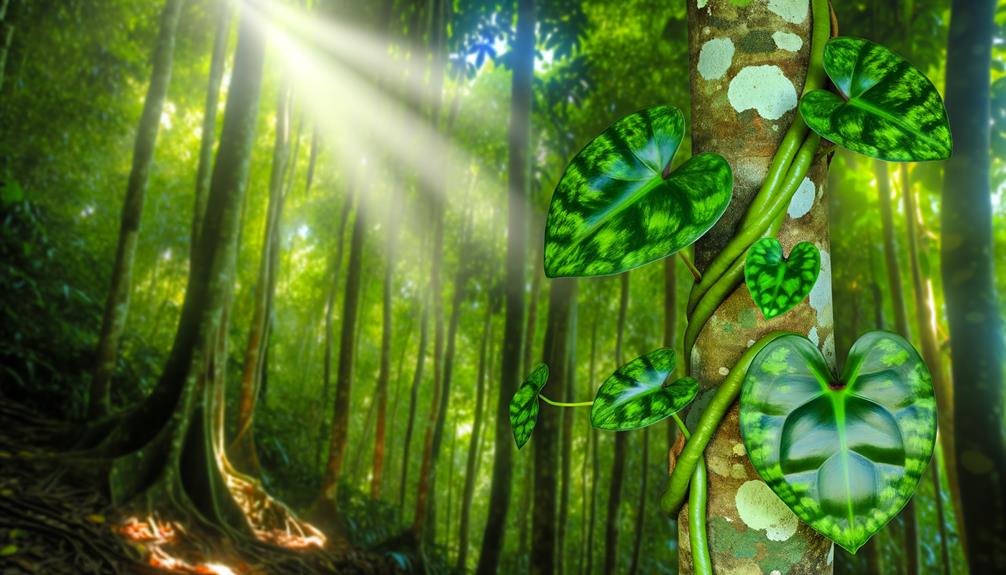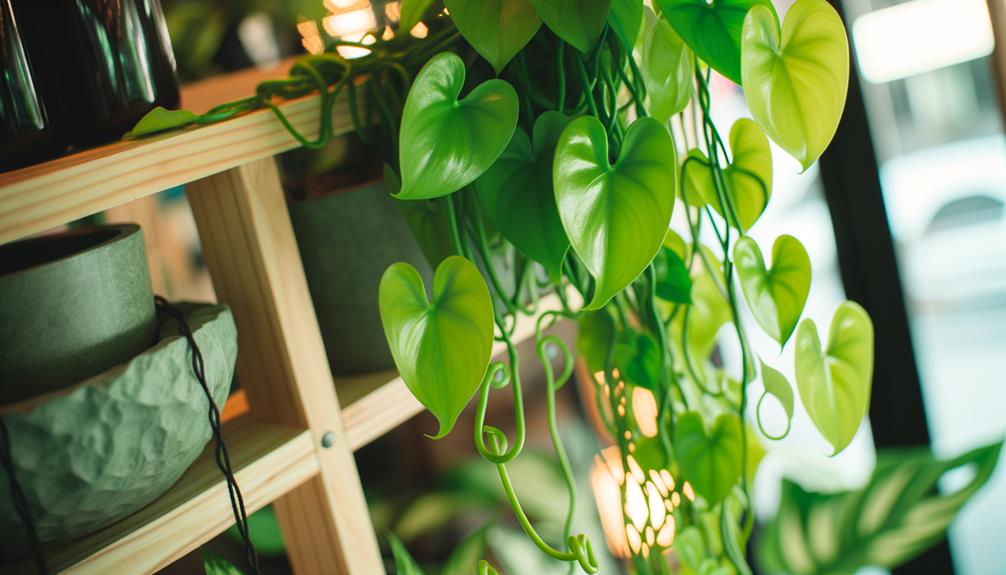What Is a Philodendron Hederaceum Green?
Philodendron hederaceum Green, a member of the Araceae family, is native to Central and South American rainforests. This plant exhibits glossy, heart-shaped, dark green leaves which can grow up to 30 cm in length.
It is an adaptable species with both epiphytic and terrestrial growth habits. Notable for its climbing and trailing capabilities, the plant features pinnate venation patterns for leaf structural integrity and aerial roots for anchorage.
Optimum growth requires high humidity, indirect light, and well-draining organic-rich soil. Issues such as root decay and pest infestations can occur if not properly managed.
Discover more detailed insights into this fascinating species.

Key Takeaways
- Philodendron hederaceum green is a tropical plant from Central and South American rainforests.
- It has glossy, heart-shaped, dark green leaves that can grow up to 30 cm long.
- The plant thrives in humid, shaded environments and can grow epiphytically or terrestrially.
- It has flexible stems with aerial roots, allowing it to climb or trail.
- Ideal care includes bright, indirect light, high humidity, and well-draining soil.
Origins

Philodendron hederaceum Green, commonly known as the Heartleaf Philodendron, originates from the tropical rainforests of Central and South America, where it thrives as an epiphytic and terrestrial plant in the understory. Belonging to the Araceae family, this species is adapted to humid, shaded environments, often growing on other plants or the forest floor.
Its ability to grow as both an epiphyte and a terrestrial plant demonstrates its ecological versatility. The genus Philodendron encompasses around 489 species, making it one of the largest genera in the Araceae family. This species is particularly noted for its climbing habit and aerenchyma tissue, which facilitates gas exchange, essential for survival in low-oxygen environments.
Its native habitat provides the best conditions for its growth and propagation.
Appearance
The Heartleaf Philodendron exhibits glossy, heart-shaped leaves that are typically dark green and can reach up to 30 centimeters in length, contributing to its aesthetic appeal and functionality as a climbing or trailing plant.
Botanically classified as Philodendron hederaceum, this species belongs to the Araceae family. Its leaves display a cordate form with a smooth, waxy texture, enhancing its visual allure and durability. The venation pattern is typically pinnate, providing structural integrity and efficient nutrient transport.
Juvenile foliage tends to be more delicate and lighter in hue, maturing into robust, darker leaves. The petioles are slender yet sturdy, supporting the foliage effectively. Overall, its morphological characteristics make it a favored choice for both indoor and outdoor ornamental use.
Growth Habits

Characterized by vigorous and adaptable growth, Philodendron hederaceum exhibits both climbing and trailing habits, facilitated by its aerial roots and flexible stems. This species, belonging to the Araceae family, employs its aerial roots to anchor itself to various surfaces, enhancing its climbing efficiency. In trailing form, the stems cascade, making it an ideal choice for hanging baskets or containers.
| Characteristics | Description |
|---|---|
| Growth Rate | Rapid, adaptable to diverse conditions |
| Stem Type | Flexible, supports climbing/trailing |
| Root Structure | Aerial roots for anchorage |
| Leaf Arrangement | Alternately arranged, heart-shaped |
| Habitat Preference | Tropical, high humidity environments |
Philodendron hederaceum's dynamic growth patterns underscore its popularity in both indoor and outdoor horticulture, demonstrating remarkable resilience and versatility.
Care Tips
Given its robust growth habits, ideal care for Philodendron hederaceum involves maintaining high humidity levels, providing indirect sunlight, and promoting well-draining soil to support its aerial roots and flexible stems. This species, belonging to the Araceae family, thrives in environments that mimic its native tropical habitat.
Key care practices include:
- Humidity: Maintain relative atmospheric moisture levels between 60-80% to prevent leaf desiccation.
- Light: Position in bright, indirect light; avoid direct sunlight to prevent foliage burn.
- Soil: Utilize a well-draining, organic-rich potting mix to facilitate root aeration and prevent waterlogging.
- Watering: Water consistently, allowing the top inch of soil to dry between waterings to prevent root rot.
These guidelines promote optimal growth and health for Philodendron hederaceum.
Common Issues

Common problems that may impact Philodendron hederaceum include root decay, pest invasions, and nutrient insufficiencies, each necessitating specific diagnostic and corrective actions. Root decay often arises from excessive watering and appears as discolored, mushy roots. Pest invasions, like spider mites and aphids, can result in visible damage and stunted growth, requiring insecticidal treatment. Nutrient insufficiencies, especially nitrogen and magnesium, typically manifest as chlorosis and call for appropriate fertilization.
| Concern | Indications |
|---|---|
| Root Decay | Discolored, mushy roots |
| Spider Mites | Fine webbing, leaf spots |
| Aphids | Sticky residue, curled leaves |
| Nitrogen Insufficiency | Yellowing older leaves |
| Magnesium Insufficiency | Yellowing between veins |
Addressing these issues promptly ensures the health and well-being of Philodendron hederaceum.
Benefits
Philodendron hederaceum is a member of the Araceae family. It offers several benefits, including its notable air purification capabilities that contribute to improved indoor air quality by removing volatile organic compounds (VOCs). This species is also characterized by low maintenance requirements, making it an ideal choice for both novice and experienced horticulturists.
Additionally, its aesthetically pleasing foliage enhances interior spaces, providing a natural and inviting ambiance.
Air Purification Qualities
Renowned for its ability to filter airborne toxins, Philodendron hederaceum Green greatly contributes to indoor air quality improvement by absorbing formaldehyde, benzene, and trichloroethylene through its foliage. This aroid, belonging to the Araceae family, utilizes phytoremediation processes to convert these volatile organic compounds into less harmful substances.
The mechanism of action involves:
- Stomatal uptake: Absorbs pollutants through leaf pores.
- Metabolic conversion: Transforms toxins via enzymatic pathways.
- Substrate interaction: Engages root-microbe symbiosis to degrade pollutants.
- Transpiration efficiency: Enhances humidity, indirectly aiding pollutant breakdown.
As a result, Philodendron hederaceum Green serves not only as an ornamental plant but also as a functional biofilter, promoting a healthier indoor environment.
Low Maintenance Needs
Requiring minimal care, Philodendron hederaceum Green is highly suited for both novice and experienced plant enthusiasts due to its adaptive growth habits and resilience to varying indoor conditions. Belonging to the Araceae family, this species demonstrates a remarkable ability to thrive in low light environments, which makes it ideal for indoor cultivation.
Its tolerance to irregular watering schedules, coupled with its resistance to common pests, further underscores its low maintenance needs. With a robust root system, Philodendron hederaceum Green can efficiently uptake nutrients from various soil types, including well-draining potting mixes.
Additionally, its climbing nature allows for versatile placement options, whether in hanging baskets or climbing structures, reducing the need for frequent repotting or elaborate care routines.
Aesthetic Appeal Indoors
Often appreciated for its aesthetic versatility, Philodendron hederaceum Green enhances indoor spaces with its lush, heart-shaped foliage and vigorous growth patterns. This species, classified under the Araceae family, provides a striking visual appeal and functional benefits in interior design. The plant's adaptability to diverse lighting conditions and its natural air-purifying properties further elevate its desirability.
Key benefits include:
- Visual Impact: The vibrant green leaves create an inviting and tranquil atmosphere.
- Versatility: Suitable for various living spaces, from offices to homes.
- Low Light Tolerance: Thrives in indirect light, making it ideal for less sunny spots.
- Air Purification: Absorbs airborne toxins, contributing to healthier indoor air quality.
These attributes make Philodendron hederaceum Green a valuable addition to any interior environment.
Conclusion
Philodendron hederaceum 'Green' exemplifies an ideal houseplant, akin to a resilient guard, thriving with minimal upkeep while enhancing indoor aesthetics. Its origins in Central and South America, coupled with its adaptable growth habits and simple care needs, render it a versatile botanical specimen.
However, watchfulness against common pests and diseases is crucial to maintain its energy. Ultimately, its air-purifying properties and aesthetic appeal contribute considerably to indoor environmental quality, underscoring its importance in botanical and residential contexts.






